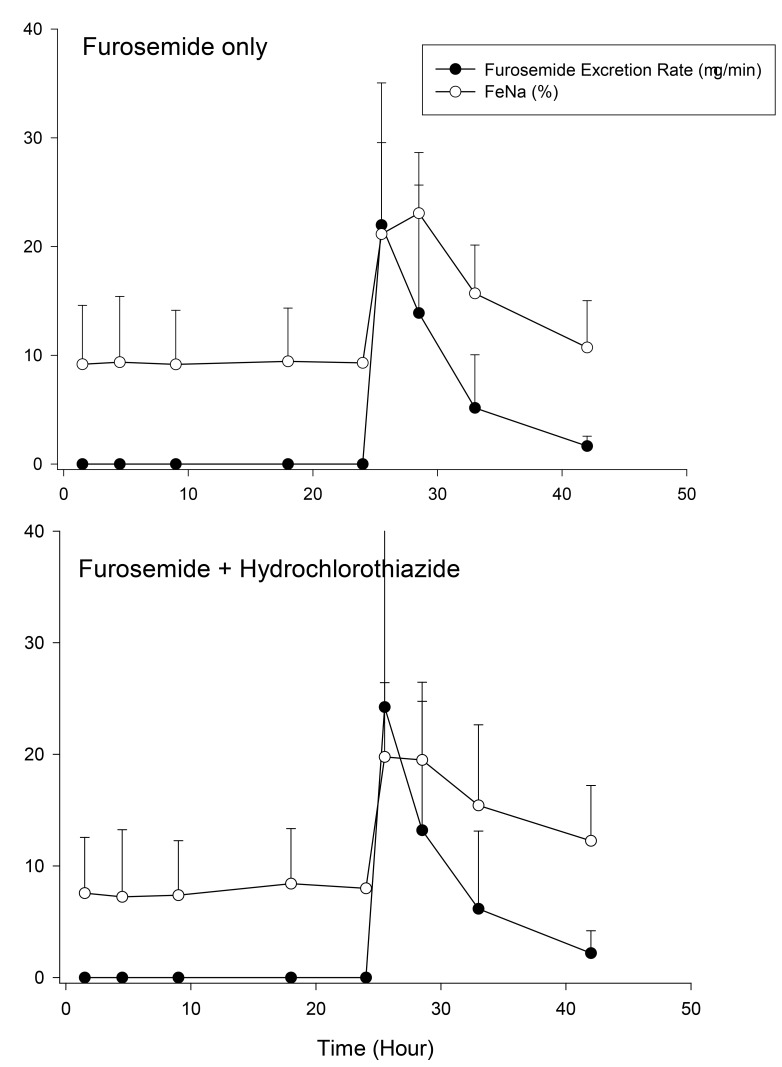Transl Clin Pharmacol.
2017 Mar;25(1):28-33. 10.12793/tcp.2017.25.1.28.
Hydrochlorothiazide does not increase furosemide's effects in end-stage renal disease
- Affiliations
-
- 1Department of Internal Medicine, Samsung Medical Center, Sungkyunkwan University School of Medicine, Seoul 06351, Korea.
- 2Department of Internal Medicine, College of Medicine, Seoul National University College of Medicine and Hospital, Seoul 03080, Korea.
- 3Department of Clinical Pharmacology and Therapeutics, Seoul National University College of Medicine and Hospital, Seoul 03080, Korea.
- 4PIPET (Pharmacometrics Institute for Practical Education and Training), College of Medicine, The Catholic University of Korea, Seoul 06591, Korea. yimds@catholic.ac.kr
- KMID: 2411416
- DOI: http://doi.org/10.12793/tcp.2017.25.1.28
Abstract
- Diuretic therapy for the treatment of edema in patients with end-stage renal disease (ESRD) is unsatisfactory, and a combination of thiazide and loop diuretics may produce better clinical effects. To evaluate the influence of thiazide on loop diuretic therapy for ESRD, we performed a crossover study of furosemide versus hydrochlorothiazide plus furosemide treatment. The diuretic effects of furosemide (160 mg i.v.) alone versus a combination of hydrochlorothiazide (100 mg p.o.) and furosemide were studied in ten ESRD patients with proteinuria greater than 1 g/day. The diuretic effects were compared for 24 h urine volume and electrolyte excretion. To detect the influence of thiazide that may have been obscured in the widely dispersed data, pharmacodynamic analysis of urine furosemide excretion rate versus fractional excretion of sodium (FeNa) was also performed using mixed-effect modeling. Combination therapy was not significantly different from furosemide monotherapy in terms of 24 h urine volume, chloride, or sodium excretion. Hydrochlorothiazide was not a significant covariate in the furosemide effect for the pharmacodynamic model. In patients with ESRD and severe proteinuria (>1,000 mg/day), the combination of hydrochlorothiazide with furosemide therapy did not increase the diuretic effect of furosemide.
Keyword
MeSH Terms
Figure
Reference
-
1. Harnett JD, Foley RN, Kent GM, Barre PE, Murray D, Parfrey PS. Congestive heart failure in dialysis patients: prevalence, incidence, prognosis and risk factors. Kidney Int. 1995; 47:884–890. PMID: 7752588.
Article2. Hörl MP, Hörl WH. Hemodialysis-associated hypertension: pathophysiology and therapy. Am J Kidney Dis. 2002; 39:227–244. PMID: 11840363.
Article3. Ritz E, Fliser D, Nowicki M, Stein G. Treatment of high doses of loop diuretics in chronic renal failure. Nephrol Dial Transplant. 1994; 9(Suppl 3):40–43.4. Loon NR, Wilcox CS, Unwin RJ. Mechanism of impaired natriuretic response to furosemide during prolonged therapy. Kidney Int. 1989; 36:682–689. PMID: 2811065.
Article6. Benet LZ, Smith DE, Lin ET, Vincenti F, Gambertoglio JG. Furosemide assays and disposition in healthy volunteers and renal transplant patients. Fed Proc. 1983; 42:1695–1698. PMID: 6339277.7. Shumaker RC. PKCALC: a BASIC interactive computer program for statistical and pharmacokinetic analysis of data. Drug Metab Rev. 1986; 17:331–348. PMID: 3569022.
Article8. Boeckmann AJ, Sheiner LB, Beal SL. NONMEM Users guide. San Francisco: University of California, USA;1992.9. Hammarlund MM, Odlind B, Paalzow LK. Acute tolerance to furosemide diuretics in humans. Pharmacokinetic-pharmacodynamic modeling. J Pharmacol Exp Ther. 1985; 233:447–453. PMID: 3999028.10. Fliser D, Schröter M, Neubeck M, Ritz E. Coadministration of thiazides increase the efficacy of diuretics even in patients with advanced renal failure. Kidney Int. 1994; 46:482–488. PMID: 7967362.11. Suki WN. Use of diuretics in chronic renal failure. Kidney Int Suppl. 1997; 59:S33–S35. PMID: 9185101.12. Brater DC. Clinical pharmacology of loop diuretics. Drugs. 1991; 41(Suppl 3):14–22. PMID: 1712712.
Article13. Ellison DH. The physiological basis of diuretics synergism: its role in treating diuretics resistance. Ann Intern Med. 1991; 114:886–894. PMID: 2014951.14. Wilcox CS, Mitch WE, Kelly RA, Skorecki K, Meyer TW, Friedman PA, et al. Response of the kidney to furosemide I: Effects of salt intake and renal compensation. J Lab Clin Med. 1983; 102:450–458. PMID: 6886524.
- Full Text Links
- Actions
-
Cited
- CITED
-
- Close
- Share
- Similar articles
-
- Effect of Furosemide on the Renal Guanylate Cyclase in Rat
- Efficacy of triple diuretic treatment in continuous ambulatory peritoneal dialysis patients: A randomized controlled trial
- Two Cases of Gitelman's Syndrome Diagnosed by Renal Clearance Study
- Changes in Renal Size by Infusion of Contrast Agent and Furosemide
- Analysis of Relationship between the Dehydration Test and the Diuretics Treatment in Definite Meniere's Disease


